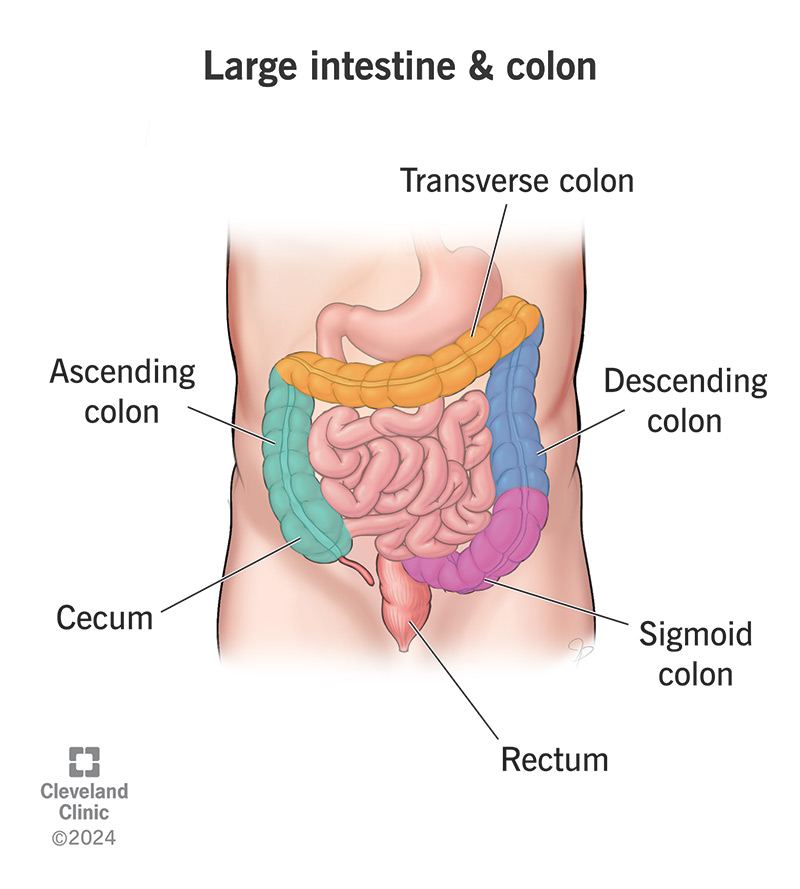Your large intestine includes your cecum, colon, rectum and anus. It’s all one, long tube that starts at your small intestine as food nears the end of its journey through your digestive system. Your large intestine turns food waste into stool and passes it from your body when you poop.
Advertisement
Cleveland Clinic is a non-profit academic medical center. Advertising on our site helps support our mission. We do not endorse non-Cleveland Clinic products or services. Policy

Your large intestine is part of your digestive system. It turns food waste into solid poop (stool) and drives the pooping process. Issues with your large intestine can lead to everyday conditions like constipation or diarrhea. They can also lead to more serious conditions like colorectal cancer. Eating well, not smoking and having screening tests for cancer can keep your large intestine healthy.
Advertisement
Cleveland Clinic is a non-profit academic medical center. Advertising on our site helps support our mission. We do not endorse non-Cleveland Clinic products or services. Policy
Your large intestine receives the liquid food waste that’s left after your small intestine completes its part of the digestive process. It absorbs water and salts from the liquid waste and turns it into solid waste (poop). Your large intestine uses layers of tissue and muscles to move poop out of your body.
Your large intestine loops around your belly and your small intestine. It moves from a spot near your right hip up to your ribs. Then, it moves across your body and back down the left side of your belly. It’s 6 feet (1.8 meters) long and about 3 inches (about 8 centimeters) in diameter.
Your large intestine has three parts: the colon, rectum and anus. Each part does specific things to keep food waste moving through your large intestine.
Your colon has five parts that work to process food waste and move waste to your rectum. Those parts are:
Advertisement
Your rectum is about 5 to 6 inches (12 to 15 cm) long. By this time in the digestive process, the parts of your large intestine reduce liquid waste by about one-third of its original size. For example, if about 16 ounces (474 milliliters) of liquid food enter your large intestine, about 5 ounces (148 ml) of that food remains as poop. When poop enters your rectum, it triggers your body’s urge to poop.
This is the canal your poop goes through to leave your body. It’s about 2 inches (5 cm) long. Your anus has muscle sphincters that manage how poop leaves your body.
A sphincter is like a fist that opens and closes. Your internal sphincter opens automatically to let poop through. The outer sphincter is the one you control to let poop out when you’re ready to go.
When poop in your rectum triggers the urge to defecate, nerve signals cause your internal sphincter to relax. This is your cue to find a toilet where you can let the poop out through your external sphincter.
It looks like a deflated tube with segments (think of the ridges in a vacuum cleaner hose). There’s a vertical seam that runs down the middle of your large intestine. The seam makes the segments bulge on the other side of it.
A wide range of conditions and diseases can affect your large intestine, including ones specific to your colon, rectum and anus. Common issues include:
Many things may signal issues in your large intestine, but some common symptoms are:
A healthcare provider may recommend you have colonoscopies to screen for colon cancer. If you have symptoms, a provider may order one or more of the following tests:
Treatments vary depending on the condition that affects your large intestine. Some common procedures are:
Advertisement
These general health guidelines will help you maintain a healthy gut:
The last stage in digestion is the making and passing of poop. Any changes you notice when you poop — or don’t — may mean there’s an issue with your large intestine. There’s a long list of conditions and issues that can affect your large intestine. Some are more serious than others. Either way, changes in your bowel habits, the color of your poop or bloated belly are things you may want to discuss with a healthcare provider. They’ll get to the bottom of your large intestine issues and recommend treatment as needed. But simple lifestyle changes can help your large intestine stay healthy. And regular colonoscopy screenings, regardless of symptoms, are a powerful way to protect your large intestine.
Advertisement
If you have issues with your digestive system, you need a team of experts you can trust. Our gastroenterology specialists at Cleveland Clinic can help.

Last reviewed on 09/19/2024.
Learn more about the Health Library and our editorial process.